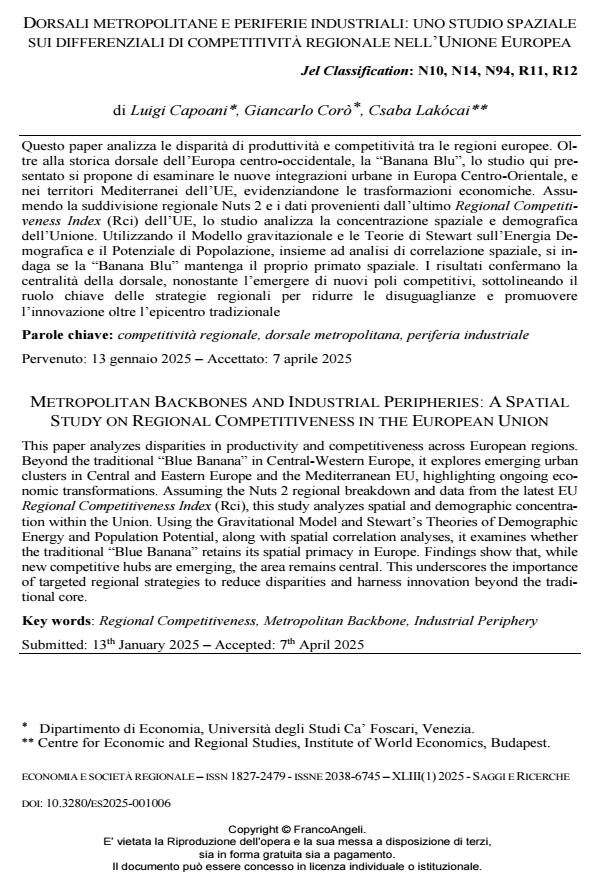Dorsali metropolitane e periferie industriali: uno studio spaziale sui differenziali di competitività regionale nell’Unione Europea
Titolo Rivista ECONOMIA E SOCIETÀ REGIONALE
Autori/Curatori Luigi Capoani, Giancarlo Corò, Csaba Lakócai
Anno di pubblicazione 2025 Fascicolo 2025/1
Lingua Italiano Numero pagine 28 P. 87-114 Dimensione file 558 KB
DOI 10.3280/ES2025-001006
Il DOI è il codice a barre della proprietà intellettuale: per saperne di più
clicca qui
Qui sotto puoi vedere in anteprima la prima pagina di questo articolo.
Se questo articolo ti interessa, lo puoi acquistare (e scaricare in formato pdf) seguendo le facili indicazioni per acquistare il download credit. Acquista Download Credits per scaricare questo Articolo in formato PDF

FrancoAngeli è membro della Publishers International Linking Association, Inc (PILA)associazione indipendente e non profit per facilitare (attraverso i servizi tecnologici implementati da CrossRef.org) l’accesso degli studiosi ai contenuti digitali nelle pubblicazioni professionali e scientifiche
Questo paper analizza le disparità di produttività e competitività tra le regioni europee. Oltre alla storica dorsale dell’Europa centro-occidentale, la “Banana Blu”, lo studio qui presentato si propone di esaminare le nuove integrazioni urbane in Europa Centro-Orientale, e nei territori Mediterranei dell’UE, evidenziandone le trasformazioni economiche. Assumendo la suddivisione regionale Nuts 2 e i dati provenienti dall’ultimo Regional Competitiveness Index (Rci) dell’UE, lo studio analizza la concentrazione spaziale e demografica dell’Unione. Utilizzando il Modello gravitazionale e le Teorie di Stewart sull’Energia Demografica e il Potenziale di Popolazione, insieme ad analisi di correlazione spaziale, si indaga se la “Banana Blu” mantenga il proprio primato spaziale. I risultati confermano la centralità della dorsale, nonostante l’emergere di nuovi poli competitivi, sottolineando il ruolo chiave delle strategie regionali per ridurre le disuguaglianze e promuovere l’innovazione oltre l’epicentro tradizionale
Parole chiave:competitività regionale, dorsale metropolitana, periferia industriale
Jel codes:N10, N14, N94, R11, R12
Luigi Capoani, Giancarlo Corò, Csaba Lakócai, Dorsali metropolitane e periferie industriali: uno studio spaziale sui differenziali di competitività regionale nell’Unione Europea in "ECONOMIA E SOCIETÀ REGIONALE " 1/2025, pp 87-114, DOI: 10.3280/ES2025-001006